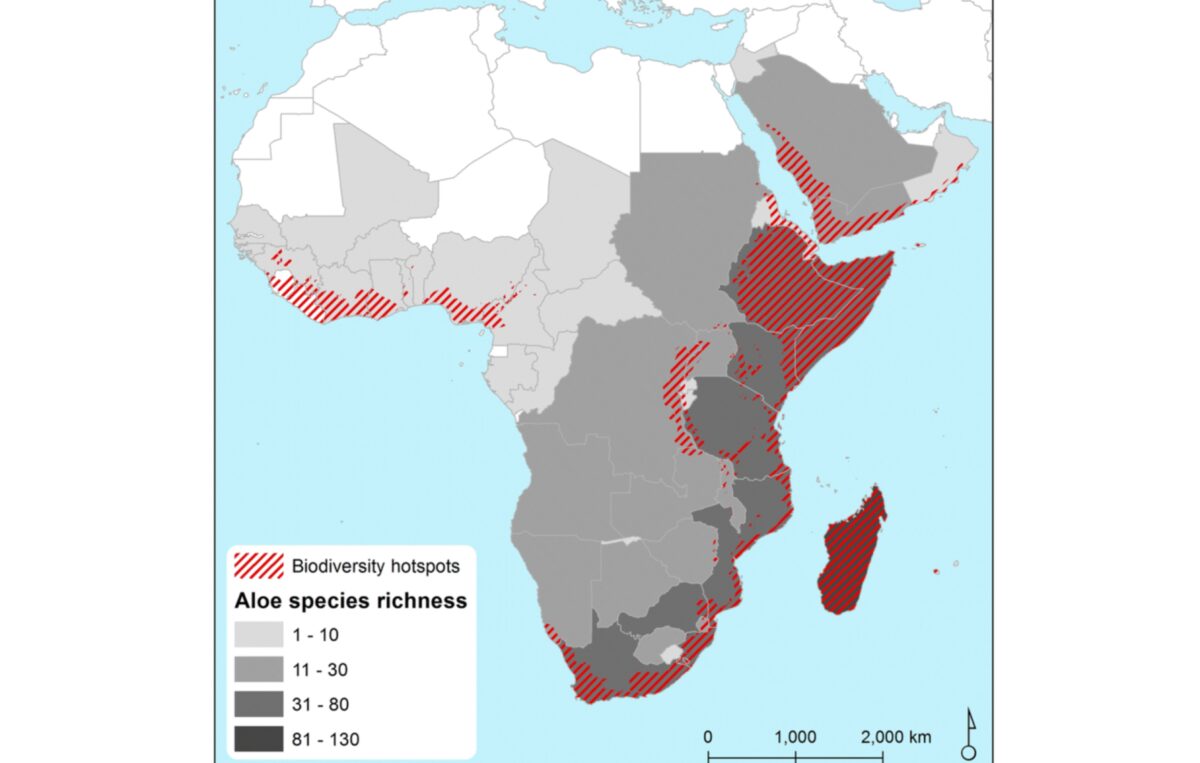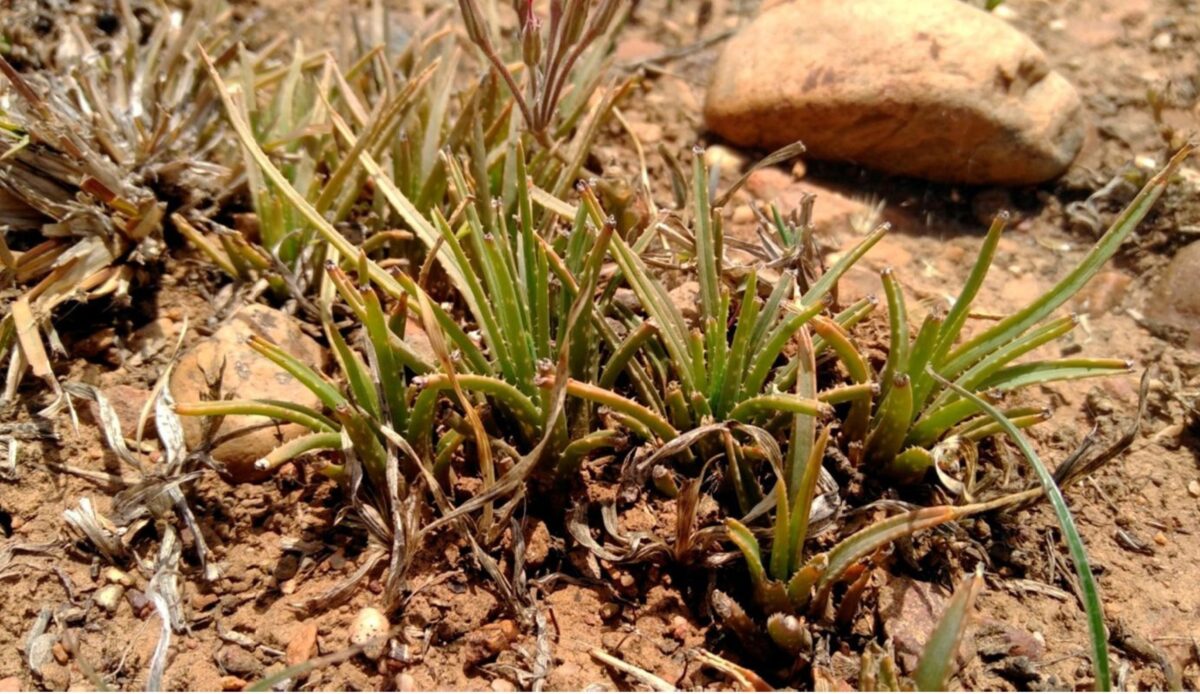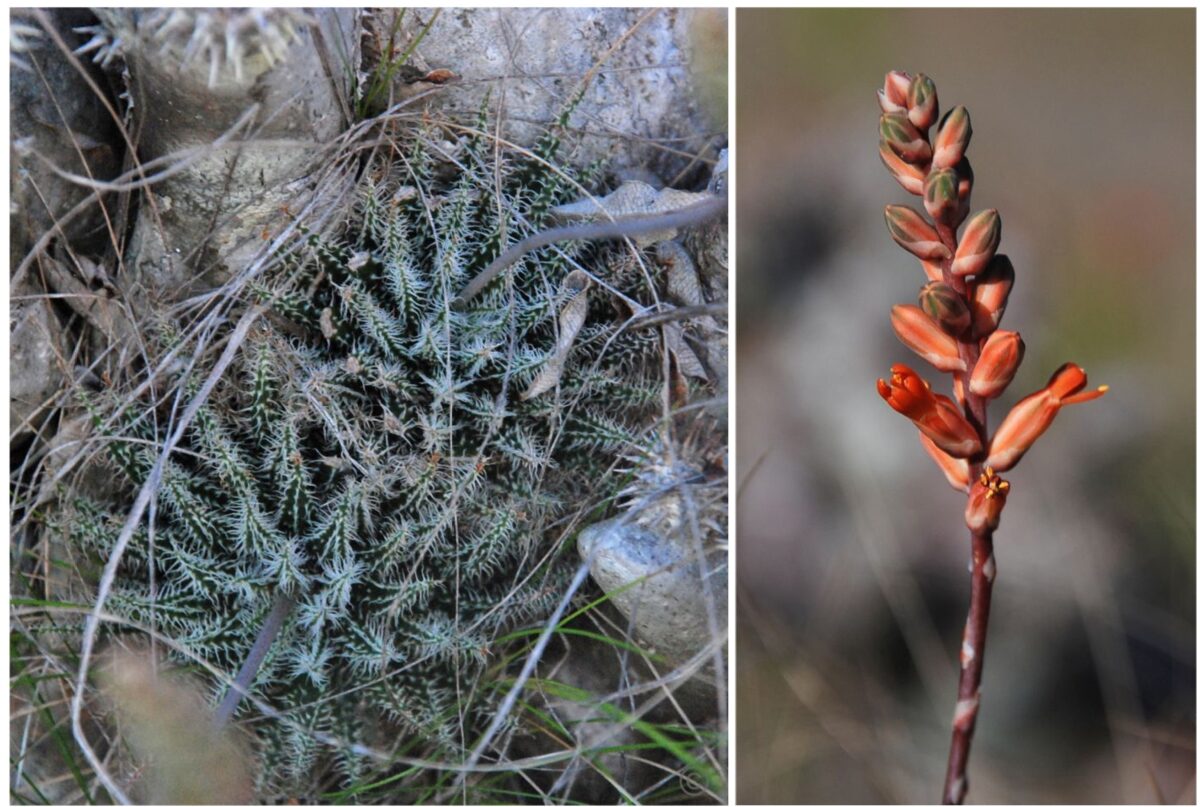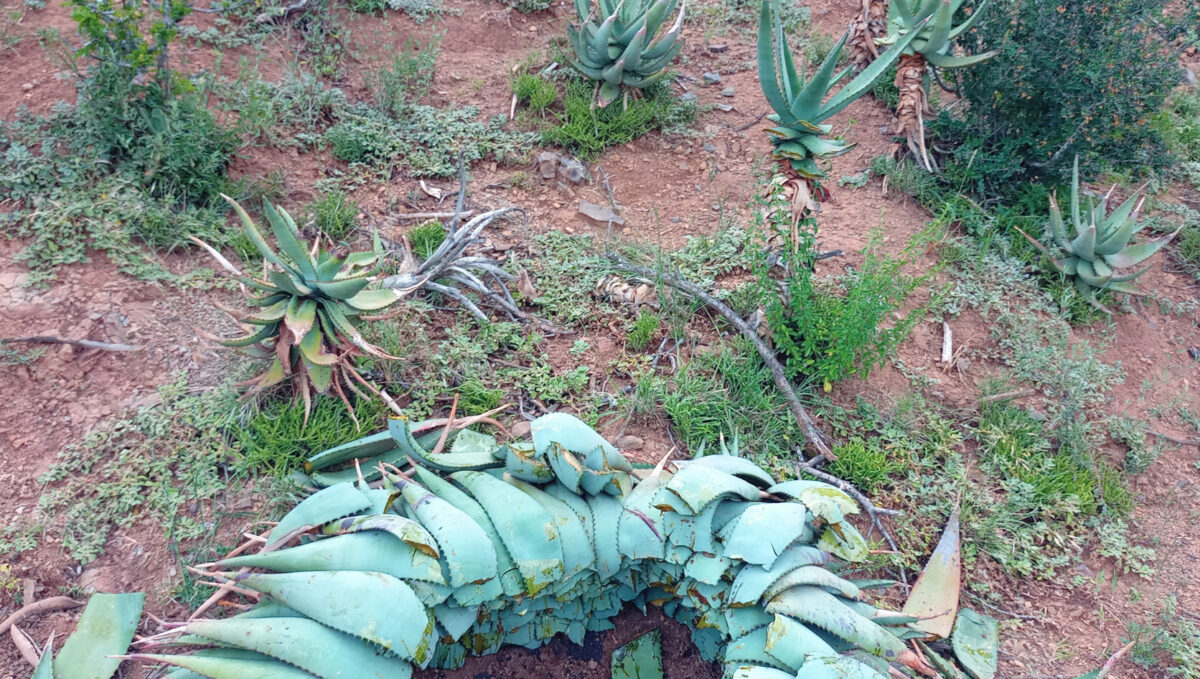The genus Aloe, much more than aloe vera

Our collaborator Carles Fabregat, botanist and collector of succulent plants, publishes a new article on the Alooideae subfamily and reveals new aspects about this botanical group so well known by plant lovers.
Explanatory note: We will give here a feminine treatment to the species that form part of the genus Aloe, even against the opinion of the Royal Spanish Academy. In its dictionary, we can see that the word can be used indistinctly with or without the accent, but that the noun is treated as masculine. This opinion is contrary to the etymological explanation given in volume XX of the Flora Ibérica, on page 308, where it establishes the use of the feminine gender for its species.
Aloe in the strict sense, the “true aloes”
It is impossible to talk about aloes without Aloe vera coming to mind, due to the great fame of this plant and its various therapeutic uses. We will not go into detail here about these uses, for which there is a lot of information available, although we will comment on some lesser known botanical aspects of this plant. But the genus Aloe means much more. Even in its restricted concept, after the relocation of some of its species into new genera, it still includes an extraordinary diversity of species, with a wide variety of floral and vegetative characters. In the following, we detail this diversity of forms, and other aspects related to the genus Aloe in its current concept.
After the separation of the genera Aloiampelos, Aloidendron, Aristaloe, Gonialoe and Kumara, the species remaining in the genus Aloe are often referred to as “true aloes”. These species are generally characterised by their rosette leaves, lanceolate in outline and usually with teeth or thorns, and by their often branched, candelabra-shaped inflorescences with large, showy, tubular flowers. However, this group of species, which still represents the majority of the genus in its classical concept, is still far from being a homogeneous group. At least four different lineages are recognised within it, treated at the infrageneric level as sections or subgenera, depending on the authors, and it is not out of the question that future genetic studies, with new molecular markers, may again divide this already restricted genus Aloe.
In its current concept, the genus Aloe still includes more than 500 species, and maintains its global area of distribution, which has recently been extended to the northwest of India, as some autochthonous species have been located there. To show its diversity of forms, we will use morphological characters, mainly vegetative, without necessarily establishing correspondences with the various infrageneric classifications, which vary according to authors.

Arborescent aloes
A good number of aloes develop tall stems with age, which separate the rosettes of leaves up to more than three metres from the ground in long-lived specimens of some species. In many cases, the stem is covered and hidden by the remains of dried leaves and is usually not very thick. This group of aloes is further divided into two groups, as some species have simple stems while others develop branched stems.
The single-stemmed arborescent aloes are reminiscent of small palm trees in appearance, and visually characterise many landscapes in central and southern Africa. They are the tallest of the true aloes: some, such as A. ballyi from Kenya and Tanzania, can reach up to six metres. Other representative examples are A. ferox, illustrated above, A. excelsa, A. africana, A. marlothii or A. littoralis.


Arborescent aloes with branched stems generally have the appearance of tall shrubs. The most characteristic example is A. arborescens, a species widely distributed in southern Africa which, because of its ornamental and medicinal uses, is also naturalised in other areas with a Mediterranean climate. Another good example is A. castanea, endemic to South Africa, which grows as a small tree with an initially simple trunk, which soon branches into a dense crown formed by several rosettes of leaves. A. pearsonii, another South African endemic with a very restricted range, forms a shrub with erect branches densely packed together. It is found exclusively in the Richtersveld, a semi-desert area between the Northern Cape and Namibia. Its small leaves fold over the stem and take on a characteristic reddish colour during long periods of drought.


Aloes acaulescent, stemless and creeping, with horizontal stems
The most numerous and most characteristic group of true aloes are the plants without an elevated stem, with rosettes of leaves growing at ground level, and the species that develop short horizontal stems that generate a creeping growth. This group includes some of the most striking and emblematic species of the genus, such as those described below.
A. peglerae is a very striking South African species, whose spiny leaves fold towards the centre of the rosette, which takes on a rounded appearance. A short-stemmed inflorescence arises from the centre of this closed rosette, so that the basal flowers are almost in contact with the leaves. A. claviflora forms clusters of rosettes from which flower stalks are borne in an almost horizontal arrangement. A. polyphylla, the spiral aloe, has large rosettes of small leaves, serrated at the margin, which are arranged in a perfect spiral. It is a much sought after species by collectors because of the geometrical perfection of the arrangement of its leaves, but it is difficult to cultivate. It is endemic to the high mountains of Leshoto, where it lives on rocky slopes that are covered with snow in winter, and requires very specific soil and environmental humidity conditions. It is currently threatened and protected by law, due to the plundering of its populations by irresponsible collectors. A. striata is an atypical species, with no teeth or thorns on its leaves, which have a smooth translucent edge and fine dark green lines on their surface. It is a very attractive plant, easy to grow, often found in gardens and collections.


A well-characterised group of species within this group are the Aloe maculata, which are distinguished by their dark green leaves, mottled with small whitish spots. They also usually have a clearly serrated leaf margin and the base of the corolla is slightly inflated. Several dozen species make up this group, sometimes very similar to each other, with A. maculata and A. grandidentata being two of the most representative and widely distributed species. In addition, A. maculata has been cultivated in gardens since ancient times, and is now naturalised in other areas with a Mediterranean climate. It is not uncommon to see it growing in the wild in our territory, from coastal cliffs to altitudes close to 1,000 m.
Finally, some species develop short horizontal stems that end in rosettes of small or medium-sized leaves, giving the appearance of low creeping shrubs. This is the case, among others, of A. mitriformis, whose rosettes resemble a bishop’s mitre, and A. arenicola, typical of the sandy soils of the Atlantic coast of South Africa and Namibia.


Aloes with berries, the ancient genus Lomatophyllum
Although currently included in the true aloes, due to their genetic proximity, the former genus Lomatophyllum remains one of the most differentiated and best characterised groups of species in the current concept of the genus Aloe. In contrast to the other species, whose fruits are dehiscent capsules that dry and open after ripening, thus releasing the seeds, the species of the former genus Lomatophyllum have fleshy, non-dehiscent fruits (berries). Their polygonal seeds are also well differentiated from the flattened seeds with narrow membranous wings of the other Aloe species.

This group consists of about 20 species endemic to Madagascar and nearby islands in the Indian Ocean, especially the Mascarene and Comoros. Vegetatively, they are characterised by their leaves without spots or thorns, and generally with a toothed margin. Their flowers are very similar to those of the other aloes. It is a clearly monophyletic group that deserves at least the rank of subgenus. Representative species are Aloe purpurea (=Lamatophyllum borbonicum, type species of the genus), A. citrea (=L. citreum), A. tormentorii (=L. tormentorii) or A. sakarahensis (=A. sakarahensis).


Herbaceous aloes
This includes a group of species characterised by their generally long, narrow leaves, which are not very succulent or not succulent at all and often look similar to the leaves of grasses. Their inflorescences are always simple, without branches, and their flowers vary in size and colour depending on the species. They are typical, but not exclusive, plants of savannah grasslands, where they are often difficult to distinguish from grasses if they are not in flower. Most of these plants flower in summer, rather than in late winter, as is the case with many other species of the genus. They are adapted to withstand the fires that frequently occur in this grassland habitat, and can lose their leaves and resprout again from the stump.
As representative examples, A. saundersiae is an endemic restricted to the central highlands of South Africa’s KwaZulu-Natal province, threatened by agricultural development in the area; it is one of the smallest species in the genus. A. cooperi has a much wider distribution, although restricted to South Africa, and is now frequently cultivated for its striking appearance and easy care. A. linearifolia is another small species from KwaZulu-Natal, with showy yellow flowers, whose specific epithet already indicates the main characteristic of this group of aloes.


The small aloes, a very complex group
In this section, as a sort of catch-all, we are going to present some discordant species, of small size and with atypical flowers for what is usual in the genus. Most of them are endemic to Madagascar, although the first one we will talk about is South African, and because of these discordant characters, some of them have been previously considered as different genera from Aloe.
A. bowiea is a small plant endemic to the Eastern Cape province of South Africa. It is characterised by its narrow, toothed leaves in the upper half, which widen and thicken at the base to form a bulb-like structure, which remains half-buried in the ground. Its atypical flowers are small, greenish-brown and slightly bilabiate at the tip. It was first described as Bowiea africana by Adrian Haworth, and later named Chamaealoe africana (Chamaealoe means “little Aloe”).
Among the Malagasy species, A. albiflora is notable for its white bell-shaped flowers, which is why it was transferred to a new monotypic genus by A. Bertrand, as Guillauminia albiflora. Its leaves, also mottled white and with a finely toothed edge, are similar to those of other species of the genus, and genetic analyses include it in the true Aloes. Also striking is the case of A. haworthioides, so named because its small, narrowly lanceolate leaves, covered with stiff whitish hairs, are reminiscent of some species of the genus Haworthia. Its small flowers are also atypical, with a whitish perianth with pink and greenish tints, and stamens much longer than this, with very thick, orange filaments. For this reason, it was separated into a new genus Aloinella by A.M.V. Lemée, without taking into account that Aloinella already belonged to a genus of mosses. As Aloinella (A. Berger) Lemée was an illegitimate name, P.V. Heat proposed the new name Lemeea haworthioides for this plant, which is now considered to be a synonym.



The cultivation and uses of aloes
The use and cultivation of aloes goes back a long way in time. Already in Arabia and classical Greece, more than two millennia ago, the healing properties of aloe vera were known, and it seems that the name of the genus Aloe, established by Linnaeus, comes from the Arabic and Semitic “alloch” or “alloeh“, the original vernacular name for these plants. From these roots comes the Greek word “áloë“, which designated the juice obtained by crushing the leaves for medicinal use. Dioscorides speaks of the medicinal properties of aloe vera as early as 512 BC, and it is said that Alexander the Great conquered the island of Socotra, off the coast of Yemen and the Horn of Africa, in order to gain control of the supply of this precious product.
The cultivation of aloe vera has spread throughout the Mediterranean since ancient times, and there are records that in 1596 it was introduced into English gardens from the island of Barbados, where it was probably brought earlier by Spanish or Portuguese sailors, who introduced it to the New World.
This long history of use and cultivation, and the consequent naturalisation of specimens in the territories where it was introduced, have for many years obscured the origin of aloe vera. Linnaeus indicated “Habitat in Indiis” for his A. perfoliata (var.) π vera, without it being clear whether this reference corresponded to India or to the Caribbean islands, which initially received the denomination of “the Indies” after the discovery. In addition, it was long thought to be native to the islands of Cape Verde, the Canaries and Madeira, although it was actually introduced there by the Spanish and Portuguese colonisers. It is now known to be native to Oman in the Arabian Peninsula and northwest India, where native populations have recently been located. This uncertainty about its origin also complicated the scientific nomenclature of the species. Its arrival in England from Barbados led Philip Miller to call the plant A. barbadensis, and this scientific name became established as the priority in the face of the apparent ambiguity of the Linnaean name. It still appears under this name in many popular publications and in the pharmacopoeia. However, the name established by Linnaeus as a variety is valid, and the correct scientific name for the species is Aloe vera (L.) Burm. f.


The medicinal use of Aloe leaves, while not extending to all species of the genus, is not exclusive to Aloe vera either. Two South African species, A. ferox and A. arborescens, are also used for similar therapeutic purposes. Freshly extracted juice from the leaves of A. ferox is used to treat burns, and evaporating the juice to lose the water yields a solid resin marketed worldwide as “Cape Aloes”. It is used as a stomach tonic, purgative and laxative. The gel made from A. ferox is also used in cosmetics and skin care. For all these reasons, the cultivation of this plant is widespread in South Africa, and represents a source of income for the South African economy. A. arborescens is mainly used in landscaping, and locally to form hedges on crop margins or livestock farms. It is often planted in private gardens for its aesthetic effect and to take advantage of its leaves for their properties, similar to those already described for A. ferox.

Finally, we cannot conclude without mentioning the enormous attraction of these plants in gardening, which has captivated horticulturists, gardeners and private individuals for centuries. Their diversity of forms, which we have illustrated here, the beauty of their flowers, the most showy among the species of the subfamily Alooideae of the family Asphodelaceae, and their resistance to drought, have made them popular in areas with a temperate and not excessively humid climate. The Jardí Botànic of the University of Valencia has a good representation of aloes in its collection of succulents, where we can find several species that we have dealt with here, such as A. arborescens, A. grandidentata, A. maculata, A. marlothii, A. mitriformis or A. striata, among others. They are relatively easy to grow, with the exception of some species with very particular soil and humidity requirements. In our territory they adapt well outdoors, needing hardly any watering other than rainfall, and for this reason many introduced species naturalise easily. For potted plants or those that do not receive direct rain, watering should be concentrated in spring and autumn, leaving them to rest in winter and also in summer. Only on very sunny exposures, and when the plants show excessive dehydration or a reddish colouring, indicating water stress, it may be advisable to water in summer. Autumn watering recovers the plant from the stress of summer, and generally favours the formation of flower buds.

Acknowledgements
To Jean-Bernard Castillon for permission to reproduce images from the book and the Madagascar aloes website.

Bibliografia
Bachman, S.P., P. Wilkin, T. Reader, R. Field, O. Weber, I. Nordal & S. Demissew. 2019. Extinction risk and conservation gaps for Aloe (Asphodelaceae) in the Horn of Africa. Biodiversity and Conservation 29: 77–98. (https://doi.org/10.1007/s10531-019-01870-0)
Castillon, J.-B. & J.-P. Castillon. 2010. Les Aloe de Madagascar / The Aloe of Madagascar. MSM Ltd., Île Maurice. (http://www.aloe-de-madagascar.com)
Grace, O.M., R.R. Klopper, E. Figueiredo & G.F. Smith. 2011. The Aloe names book. Strelitzia, 28. South African National Biodiversity Institute, Pretoria, and the Royal Botanic Gardens, Kew. (http://biodiversityadvisor.sanbi.org/literature/4327-2/strelitzia/)
Newton, L.E. 2001. Aloe. In U. Eggli (ed.), Illustrated Handbook of Succulent Plants: Monocotyledons. Pp. 103-186. Springer Verlag, Berlin.
Reynolds, G.W. 1950. The Aloes of South Africa. The Aloes of South Africa Book Fund, Johannesburg.
Reynolds, G.W. 1966. The Aloes of Tropical Africa and Madagascar. The Aloes Book Fund, Mbabane.
Van Wyk, B.-E. & G.F. Smith. 2014. Guide to the Aloes of South Africa. Third Edition. Briza Publications, Pretoria.





